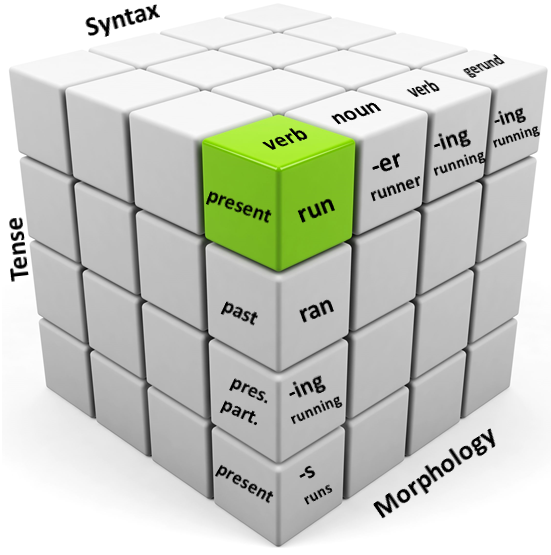08 May Three-Dimensional Model of Language
 Topographical maps of concepts in a text provide useful views of language. Fortuna et al in Semantic Knowledge Management (pp. 155-169) describe how three-dimensional topic maps can both give meaningful insights into clusters of related content, such as news stories or published papers. I have frequently stressed the importance of concept associations in the brain, in cognitive processes and in language. Mapping such associations can help understand the context and relationships of objects. “For example, given a stream of news articles, one can apply visualizations on the named-entities that appear in the corpus to show their topical context… and topical relations between different named-entities” (Davies 2009 p. 156).
Topographical maps of concepts in a text provide useful views of language. Fortuna et al in Semantic Knowledge Management (pp. 155-169) describe how three-dimensional topic maps can both give meaningful insights into clusters of related content, such as news stories or published papers. I have frequently stressed the importance of concept associations in the brain, in cognitive processes and in language. Mapping such associations can help understand the context and relationships of objects. “For example, given a stream of news articles, one can apply visualizations on the named-entities that appear in the corpus to show their topical context… and topical relations between different named-entities” (Davies 2009 p. 156).
In the 3-Dimensional model for language I propose, the topical context forms only one of the dimensions, while the linguistic strata form another dimension (which in itself is multi-dimensional), and the real-world context (time, location, subtext, exformation, etc.) forms the third dimension. This section, and this post are mostly focused on the linguistic dimension, but I’ll return to the other dimensions periodically in future posts.
| Understanding Context Cross-Reference |
|---|
| Click on these Links to other posts and glossary/bibliography references |
|
|
|
| Prior Post | Next Post |
| Pairs of Language Strata | Stratum Morphology |
| Definitions | References |
| association syntax ambiguity | Stanford's CSLI |
| morphology phoneme anaphora | Lamb 1964 |
| semantic structure context | Huang 2007 |
The 3-D Model
You can lay out the attributes of a word using two-dimensional matrices. Doing so associates the morphological form of each word with its phonological and syntactic features or attributes. This represents a pairing of the strata of morphology and phonology, and morphology and syntax. Syntax is further paired with semantic attributes possessed by each syntactic structure. The union of these conjoined planes may be visualized as a cube. Every word has its own cube which is a complete grammar. In this example, the edge between morphology and syntax shows how morphology changes affect syntactic role and tense.
Certain sentence attributes must be understood to correctly interpret meaning. Words or phrases alone do not always indicate whether a sentence is imperative, declarative or interrogative. Certain forms of ambiguity can only be resolved by extracting contextual information from sentences. Understanding context, a central subject of Stanford’s CSLI Situated Language projects, is essential for robust understanding of natural language (NL) input. In addition to the resolution of ambiguity, retrieving contextual information from sentences enables the resolution of anaphora.
 What Holds Them Together
What Holds Them Together
Having identified the essential linguistic strata, we can now explain why the pairings of strata are so important. Remember, linguistic strata are most strongly paired according to their hierarchy, so phonology is paired with morphology, morphology with syntax, and so on. Conceptually, this structure is rather intuitive. Other pairings exist, especially for prosody at the surface level and pragmatics in depth, but the most profound cues and changes occur at the boundaries between these paired strata. Computationally, it is indispensable to know the rules, and leverage them to achieve understanding. We have briefly described 3-DG structure as an inherently parallel grammar formalism. Now consider a functionally oriented description.
If we treat the pairings of strata as the most relevant aspects of language understanding, acknowledging that surface features of text or speech are the most accessible to the interpreter (biological or other), then it seems logical to begin with an integrated morphological/syntactic analysis and proceed to a syntactic/semantic parse. If it is reasonable to expect the interpreter to be able to make use of pragmatic knowledge, as human interpreters do, it is equally reasonable to add a semantic/pragmatic component to the analyzer. All these elements could be incorporated as separate modules that execute in sequence, one after the other, or in parallel if concurrent processing is available on the equipment.
What can we do to exploit the clues provided by stratified phenomena to improve, strengthen, and expedite automated disambiguation procedures? In order to answer this question, we must first identify those phenomena available for exploitation. Humans can conceptually pull lines, colors and textures out of images very rapidly to determine their features. Though language is much more abstract, humans can efficiently determine tense, number, gender, and other features from words instantaneously. The same is true for meaning.
Prosody and Phonology
Prosody refers to changes in vocal intonation, while phonology refers to the sounds that words make. Together, they comprise the surface-level features of spoken language. No corresponding features exist in written language unless you consider text formatting – all capital letters, bold or italic fonts, underscoring, and punctuation marks – to be meaningful parts of language. Certainly, these things mean something to the author if not to the reader.
 Hearers (or comprehenders in the communication model) get their first cues for interpreting input from the audible features produced by the speaker. Differences in intonation (prosody) can add shades of meaning or change the interpretation of an utterance. Consider this example:
Hearers (or comprehenders in the communication model) get their first cues for interpreting input from the audible features produced by the speaker. Differences in intonation (prosody) can add shades of meaning or change the interpretation of an utterance. Consider this example:
“That was my plan” may be interpreted as
“I no longer intend to do what I had planned”
while
“That was my plan” may be interpreted as
“I deserve the credit for the plan, and he doesn’t.”
If the words in bold above are emphasized with vocal intonation, the correct meaning is easy for humans to infer. Not everyone can always easily interpret these cues in normal conversation, but most of us can most of the time.If there are clues in the context or the surrounding sentences, it could be possible for a machine to infer the correct meaning.
The implication of this helps us better understand the meaning of “taking a statement in context” in language interpretation. Context includes not only the normal contextual elements of time and location and topic, but context includes correct interpretations of the surrounding sentences. I can think of many times when I only truly understood what a person was saying several sentences after. The implications of this phenomenon for automated language understanding are very significant, and will require careful design.
| Click below to look in each Understanding Context section |
|---|









